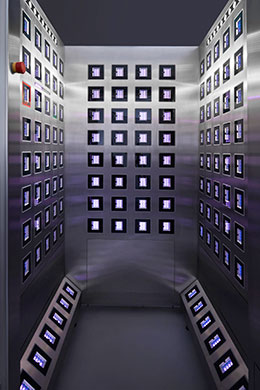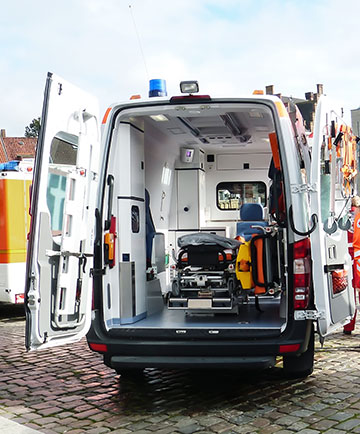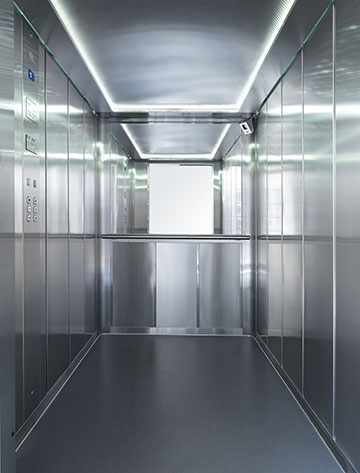![]()
Nicolas Volet [Image: UV Medico]
The July/August 2025 issue of Optics & Photonics News featured the magazine’s biennial spotlight on 10 Entrepreneurs to Watch. Here, we present an interview with one of those innovators, Nicolas Volet, cofounder and CTO of UV Medico. UV Medico is a Danish company dedicated to creating safe and efficient far-UVC light-emitting devices that prevent the spread of infectious viruses and bacteria.
How did you start your journey into entrepreneurship? What inspired you to start your own company?
When the pandemic began, my research focused on integrated photonics, mainly for applications in communication and sensing. Like many others, I started questioning where our tools could have the most immediate societal impact. That led us to look at ultraviolet (UV) light and its potential role in limiting airborne transmission.
We began looking into far-UVC light, which is defined as wavelengths between 200 and 230 nanometers. This range was shown to deactivate airborne viruses while remaining safe for direct human exposure within well-established limits. The dose needed to eliminate pathogens is well below the safety threshold, which made it viable for real-world use.
The project gained momentum because we had people ready to contribute. One of them, Emil Ulsig, was completing his master's degree when we started. We also had collaborators with experience in virology, policy, and business. That mix allowed us to move quickly and cover ground none of us could have covered alone.
From the beginning, we saw that making an impact would require more than publishing results. The technology had to be manufactured, regulated, and understood outside our own field. It needed to become something reliable and usable in everyday settings.
Tell us about UV Medico.
The idea began to take shape just before the pandemic, as we were exploring how UV light could help limit the spread of infections in agriculture. When COVID-19 emerged, the urgency shifted, and it became clear that the same wavelength range could be relevant in broader public settings.

UV Medico's UV booth [Image: UV Medico]
Some of the early contributors came from outside research and academia. Our chairman, for example, had worked for decades in the entertainment lighting industry, where LED technologies are essential. That entire sector was shut down during the lockdowns, and many experienced professionals were looking to redirect their skills toward something more immediately impactful. That combination of backgrounds helped shape UV Medico from the start.
Today we are a team of around 35 to 40 people based in Denmark, with activities in more than 60 countries. Many of our colleagues are still students, working part time while continuing their degrees. That close connection to the academic environment, and the ability to test and iterate ideas quickly, has remained one of the core strengths of the company.
What problem does UV Medico solve?
Our systems use far-UVC light to reduce the spread of airborne viruses and bacteria in shared indoor environments. What makes this possible is the specific wavelength range, which can inactivate pathogens while remaining safe for direct human exposure within regulated limits. That makes it feasible to use in places where people are present.
The core idea is to take a technology that already exists and make it usable at scale. Far-UVC excimer lamps have been around, but they were too expensive and impractical for widespread deployment. We saw an opportunity to improve the engineering, reduce the cost, and help bring this out of research settings and into broader use.
What makes the technology unique in the optics and photonics space?
The key factor is the wavelength. Far-UVC light, between 200 and 230 nm, is strongly absorbed in the outermost layers of skin and eyes, which are made of dense proteins and non-living cells. As a result, the light does not penetrate living tissue. This allows it to inactivate viruses and bacteria while remaining within known safety limits for human exposure.
Our work also focuses on how to make this technology smaller and more widely deployable. That includes moving from gas-based excimer lamps to solid-state sources using blue laser diodes and nonlinear waveguides. We start from established components, but reconfigure them to operate in the deep-UV, where off-the-shelf solutions do not exist. That shift opens new possibilities for integration and long-term reliability.
What were the biggest challenges in setting up the company?
One of the early challenges was earning trust. Far-UVC light is not widely known, and most people associate UV exposure with harm. So the burden is on us to invite independent scrutiny. Safety has to be tested, understood, and communicated clearly.

A simulated image of the UV technology used in an ambulance. [Image: UV Medico]
We’ve made a point of sharing knowledge and encouraging others to run their own tests. We collaborate with groups like the International UV Association, the European Photonics Industry Consortium (EPIC), and the Danish Optical Society (DOPS), and we help bring researchers and regulators together to compare results and experiences. It takes a broad base of evidence for new technologies to gain acceptance, especially when health is involved.
Like many startups, we’ve also had to navigate the realities of funding. The need for better tools against airborne disease hasn’t gone away, even if it’s less visible now. Many people remain vulnerable, and future outbreaks are inevitable. We believe it’s worth continuing this work even when attention shifts elsewhere.
Was there a breakthrough moment when you realized UV Medico was a sustainable company?
There was no single moment. It was more a series of small but meaningful steps, such as hiring the first team members, entering new markets, and forming key partnerships. Each step made it clearer that this could grow into something stable and long term.
One important milestone was technical. We had been working on alternatives to gas-based lamps, exploring ways to generate far-UVC light from solid-state sources. When we first measured a clear signal around 222 nm using a blue laser diode and a nonlinear waveguide, it confirmed that our approach could work. That result took years of collaboration across multiple labs and teams, and it gave us something concrete to build on.
You mentioned interdisciplinarity and collaboration. How important are those for innovation?
Collaboration across disciplines has been crucial. Photonics alone would not have taken us very far. The technology had to be understood in a biological context, evaluated for public health use, and made accessible beyond research labs. That meant involving people with backgrounds in virology, policy, manufacturing, and business.
Our CEO comes from virology and academic medicine. Our former CEO had experience in government and international affairs. Our chairman, Peter Johansen, has worked in entrepreneurship for decades and has been a mentor to many of us. These different perspectives have helped us make better decisions and stay grounded. Innovation came not just from new technical ideas, but from how those ideas were shaped by people with different ways of thinking.
Does your academic background help with credibility?

The UV light in an elevator. [Image: UV Medico]
It helps, especially when it comes to evaluating evidence. I was skeptical at first when I heard that far-UVC light could be safe for human exposure. Most of us are taught that UV light is harmful, that we should wear sunscreen and avoid direct exposure. But having a research background gave me the tools to read the data closely and question my assumptions.
That approach has stayed with us as the work moved forward. We continue to collaborate with others and invite outside perspectives. The process of testing, revising, and staying open to challenge is something we rely on, both in the lab and beyond it.
And what are your plans for the next three to five years? How do you think that your technology is going to impact the field or the industry?
We are working to expand into areas where deep-UV light can offer clear technical advantages. That includes pharmaceutical manufacturing, cleanroom environments, spectroscopy, and even free-space communication. Each of these fields has specific challenges where our experience with compact, narrowband far-UVC sources could make a real difference.
For example, far-UVC light scatters strongly in air, which could be used for non-line-of-sight communication in certain conditions. In spectroscopy, access to affordable deep-UV lasers could significantly reduce background signals and enable new types of measurements. But today those sources are still bulky and expensive. We are trying to change that by developing more compact and cost-efficient systems that build on our existing platform.
What have you learned that you’d pass on to other entrepreneurs?
Stay curious, and stay open. Focus matters, but so does flexibility. During the pandemic, many companies focused only on COVID-19. When that urgency faded, some of them disappeared. From the beginning, we looked at other areas where the same technology could be useful, including cleanrooms, food production, and animal health. That helped us build something more resilient.
You don’t need perfect timing or the perfect background to begin. What matters more is having a question you care about, being willing to listen, and surrounding yourself with people who think differently from you. That mix of perspectives has been essential for us, and it continues to shape the way we work.

